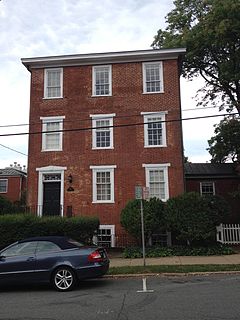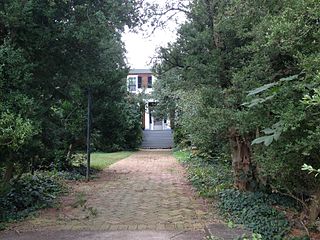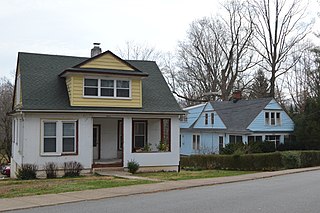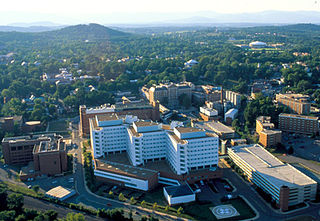
Buildings, sites, districts, and objects in Virginia listed on the National Register of Historic Places:

Memorial Gymnasium is a 2,500 seat multi-purpose arena in Charlottesville, Virginia. It opened in 1924. It replaced Fayerweather Gymnasium as home to the University of Virginia Cavaliers basketball team until University Hall opened in 1965.

The Virginia Landmarks Register (VLR) is a list of historic properties in the Commonwealth of Virginia. The state's official list of important historic sites, it was created in 1966. The Register serves the same purpose as the National Register of Historic Places. The nomination form for any Virginia site listed on the VLR is sent forward to the National Park Service for consideration for listing on the National Register.

Clark Hall is a building on the campus of the University of Virginia in Charlottesville, Virginia. It was completed in 1932 to hold the university's School of Law. Its two-story, sky-lit, mural-decorated Memorial Library room "is one of the Commonwealth's most significant 20th-century architectural interiors". The building was listed on the National Register of Historic Places on September 5, 2008.

Huntley, also known as Historic Huntley or Huntley Hall is an early 19th-century Federal-style villa and farm in the Hybla Valley area of Fairfax County, Virginia. The house sits on a hill overlooking Huntley Meadows Park to the south. The estate is best known as the country residence of Thomson Francis Mason, grandson of George Mason of nearby Gunston Hall. It is listed on the National Register of Historic Places (NRHP), the Virginia Landmarks Register (VLR), and the Fairfax County Inventory of Historic Sites.

Pine Knot is a historic cabin located 14 miles south of Charlottesville, Virginia in Albemarle County, Virginia. The cabin was owned and occupied by former President of the United States Theodore Roosevelt and his wife Edith Kermit Roosevelt, and used by Roosevelt and the first lady while he was president, although no official business took place there. In 1905, Mrs. Roosevelt spent $280 to purchase the fifteen-acre property with its rustic worker's cabin, and she bought an additional seventy-five acres in 1911. The cabin is owned by the Edith and Theodore Roosevelt Pine Knot Foundation and is open for visits by appointment.

Woolen Mills Chapel is a historic chapel located at 1819 E. Market Street in Charlottesville, Virginia. The Late Victorian building was constructed in 1887.

Woolen Mills Village Historic District is a historic district that was listed on the National Register of Historic Places on April 12, 2010. The district is in Albemarle County, Virginia and also in Charlottesville, Virginia.

Farmington is a house near Charlottesville, in Albemarle County, Virginia, that was greatly expanded by a design by Thomas Jefferson that Jefferson executed while he was President of the United States. The original house was built in the mid-18th century for Francis Jerdone on a 1,753-acre (709 ha) property. Jerdone sold the land and house to George Divers, a friend of Jefferson, in 1785. In 1802, Divers asked Jefferson to design an expansion of the house. The house, since greatly enlarged, is now a clubhouse.

Carter–Gilmer House is a historic home located at Charlottesville, Virginia. It was built about 1820, and is a three-story, three bay, Federal style brick townhouse dwelling. The house has been divided into apartments.

Locust Grove is a historic home located at Charlottesville, Virginia. It was built between 1840 and 1844, and is a two-story, five-bay, Georgian style brick dwelling. It has a hipped roof and end chimneys. On the front facade is a portico with coupled paneled columns. Also on the property are a contributing original kitchen and smokehouse.

Abell–Gleason House is a historic home located at Charlottesville, Virginia. It was built in 1859, and is a two-story, three bay, Greek Revival style brick dwelling. Each of the bays is defined by brick pilasters with Doric order inspired capitals faced with stucco. Also on the property is a contributing four room servants quarters.

Montebello is a historic home located at Charlottesville, Virginia. The central section was built in 1819-1820, and consists of three-part facade, with a three bay, two-story central block with single-story flanking wings. The original section has a single pile, brick I-house plan with a central hall flanked by a room on each side. Also on the property is a contributing 1 1/2-story, brick, two-car garage. The house was built by John M. Perry, one of the workmen who worked with Thomas Jefferson at Monticello and on his many building projects at the University of Virginia. The University of Virginia purchased the house and property in 1963 and it currently serves as a residence for faculty.

Sunnyside, also known as the Duke House, is a historic home located at Charlottesville, Virginia. The original section was built about 1800, as a 1 1/2-story, two room log dwelling. It was expanded and remodeled in 1858, as a Gothic Revival style dwelling after Washington Irving's Gothic Revival home, also called Sunnyside. The house features scroll-sawn bargeboards, arched windows and doors, and a fieldstone chimney with stepped weatherings and capped corbelled stacks topped with two octagonal chimney pots.

Thomas Jonathan Jackson is a historic bronze equestrian sculpture of Stonewall Jackson located at Charlottesville, Virginia. It was sculpted by Charles Keck (1875-1951), and was the third of four works commissioned from members of the National Sculpture Society by Paul Goodloe McIntire. The sculpture was the second of three McIntire gave to the city during the years 1919 to 1924. It was erected in 1921. All four sculptures are located in Charlottesville.

Charlottesville and Albemarle County Courthouse Historic District, also known as the Charlottesville Historic District is a national historic district located at Charlottesville, Virginia. The district encompasses the previously listed Albemarle County Courthouse Historic District and includes 269 contributing buildings and 1 contributing object in the city of Charlottesville. It includes the traditional heart of the city's commercial, civic, and religious activities, with early residential development and industrial sites located along the fringe. The commercial core is located along a seven block Downtown Mall designed by Lawrence Halprin (1916-2009). Notable buildings include the Albemarle County Courthouse, Levy Opera House, Number Nothing, Redland Club, Eagle Tavern, United States Post Office and Courts Building (1906), Christ (Episcopal) Church (1895-1898), Beth Israel Synagogue (1882-1903), Holy Comforter Catholic Church (1925), First Methodist Church (1924), McIntire Public Library (1919-1922), and Virginia National Bank (1916). Also located in the district are the separately listed Abell-Gleason House, William H. McGuffey Primary School, Thomas Jonathan Jackson sculpture, Robert Edward Lee sculpture, and Marshall-Rucker-Smith House.

Rugby Road–University Corner Historic District is a national historic district located at Charlottesville, Virginia. The district encompasses 173 contributing buildings in the city of Charlottesville. It includes a variety of commercial, residential, and institutional structures mirroring the University of Virginia's development between the 1890s and the Great Depression. It includes properties on Carr's Hill. Notable buildings include the Chancellor Building (1920), the Minor Court Building, Mincer's Shop Building 1920s), the Stevens-Shepherd Building, Buckingham Palace, St. Paul's Episcopal Church (1926–27), Madison Hall (1905), fraternity houses dating from 1902 to 1928, Fayerweather Hall (1893), the Bayly Museum (1934), Faculty Apartments building, Watts-Hillel House (1913-1914), and Hotopp-Watson House (1900). Also located in the district are the separately listed Anderson Brothers Building, Preston Court Apartments, and Wynhurst.

Oakhurst–Gildersleeve Neighborhood Historic District is a national historic district located at Charlottesville, Virginia. The district encompasses 78 contributing buildings in a primarily residential section of the city of Charlottesville. It was developed between 1910 and the 1960s and includes examples of the Bungalow, Colonial Revival, and Tudor Revival styles.

Fifeville and Tonsler Neighborhood Historic District is a national historic district located at Charlottesville, Virginia. The district encompasses 264 contributing buildings and 3 contributing sites in a predominantly African-American residential section of the city of Charlottesville. It was developed between 1890 and the 1930s and includes examples of the Bungalow and Gothic Revival styles. The oldest is dated to 1822. Located in the district are the separately listed Oak Lawn, Benjamin Tonsler House, Delevan Baptist Church, and Gardner-Mays Cottage.

The Fry's Spring Historic District encompasses a residential neighborhood of Charlottesville, Virginia, which was developed between 1890 and 1963. Prior to its development, it was a largely wooded area owned for much of the 19th century by the Fry family. The 150-acre (61 ha) district is centered on the private Fry's Spring Beach Club, whose property includes the eponymous spring, and includes 300 mainly residential buildings with historic character. The architectural styles that predominate in the district are Craftsman and Colonial Revival, although other revival styles such as the Spanish and Tudor Revival are represented by smaller numbers of buildings. There are also four churches in the district. The district extends southward along Jefferson Park Avenue, south of the railroad tracks, and radiates out along Stribling, Todd, Robert, and Raymond Avenues as far as Highland Avenue. Another cluster of streets at the southern end of the district includes Jefferson Park Circle, and portions of Eton Road and Monte Vista Avenue.


























